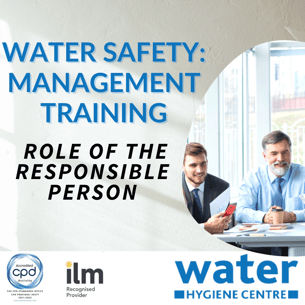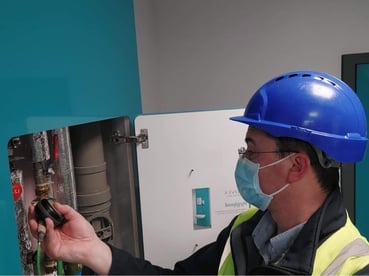What is the appetite for risk amongst managers of education estates with responsibility for health & safety? We would expect such organisations to operate on the basis that risks to health and safety should be ‘as low as reasonably practicable’. For example, when there is a broken window, missing or broken paving slab or a blocked fire exit these obvious issues would be fixed promptly to avoid injury to pupils/students, staff and visitors.
However, when managing the Legionella risks within an educational organisation, the hazards contained within water systems are not always visible. Moreover, hazards are hidden around the building; lost behind panelling, within the building fabric, under floors, in ducts, in ceiling voids, roof spaces, behind fixtures or furniture or even in your office!
What Is Legionella? Understanding Bacteria and Its Risks
 Legionella are naturally occurring bacteria that live within water. When favourable conditions are allowed to develop in engineered water systems within buildings, these bacteria can proliferate and potentially colonise your domestic water system. When water is used, i.e., through running a tap or flushing a toilet, very fine droplets of water are released as an aerosol, which can carry the bacteria in the air. If a person breathes in this aerosol containing Legionella bacteria, they may develop legionellosis.
Legionella are naturally occurring bacteria that live within water. When favourable conditions are allowed to develop in engineered water systems within buildings, these bacteria can proliferate and potentially colonise your domestic water system. When water is used, i.e., through running a tap or flushing a toilet, very fine droplets of water are released as an aerosol, which can carry the bacteria in the air. If a person breathes in this aerosol containing Legionella bacteria, they may develop legionellosis.
Legionellosis is the collective term for diseases caused by Legionella bacteria and includes Legionnaires’ disease, Pontiac fever, and Lochgoilhead fever. Legionnaires’ disease is a potentially fatal form of pneumonia, to which certain groups of people are more susceptible than others and, although anyone can catch Legionnaires’ disease, new-born babies, males, smokers, the over fifties, the immuno-compromised or those with underlying health issues are more at risk.
It is a requirement of the Management of Health & Safety at Work Regulations and the Control of Substances Hazardous to Health Regulations that suitable and sufficient management processes, training, risk assessment and monitoring arrangements are in place for health and safety issues, of which Legionella risk management is included.
The Health & Safety Executive’s Approved Code of Practice [ACoP] L8 and the associated HSG274 Technical Guidance are freely available for all, especially those identified as being responsible for the management of Legionella.
We’ve prepared a five-step guide for managers of educational estates responsible for managing Legionella risk within their organisation e.g., school, academy, college or university.
Step One:
Management, Communication & Legionella Training.
 Inadequate management, poor communication, and insufficient Legionella training have all been identified as contributory factors to outbreaks of Legionnaires’ disease. The aforementioned ACoP L8 outlines the need to:
Inadequate management, poor communication, and insufficient Legionella training have all been identified as contributory factors to outbreaks of Legionnaires’ disease. The aforementioned ACoP L8 outlines the need to:
- Appoint a Responsible Person; who must have sufficient authority, knowledge, and competence.
- Prepare a Legionella Written Scheme of Control or Water Safety Plan; which details management roles, responsibilities, communication pathways, Legionella training, and operational control processes for water risk systems [including design, operation, monitoring and maintenance].
Education estates managers can take early intervention when it comes to pitfalls of Legionella risk management by attending a quality training course.
Legionella Training should not only list the requirements of the various legislation and guidance but also provide a practical approach as well, e.g., what does a typical water system comprise of, where potential issues can be found, and why do they occur?
Learn more about our Legionella Awareness training, ideal for caretakers & janitors
Step Two:
Independent Advice e.g., Authorising Engineer (Water)
 The Management of Health and Safety at Work Regulations state that organisations should have ‘access to competent health & safety advice’. If the required subject knowledge and/or level of competence does not exist within the organisation, then duty holders may seek to employ a specialist adviser to contribute towards overall health & safety management.
The Management of Health and Safety at Work Regulations state that organisations should have ‘access to competent health & safety advice’. If the required subject knowledge and/or level of competence does not exist within the organisation, then duty holders may seek to employ a specialist adviser to contribute towards overall health & safety management.
These ‘expert specialist advisors’ must demonstrate their competency and knowledge and be able to demonstrate impartiality, integrity, and sound reasoning, with evidence, for any proposed course of action or advice given.
To help demonstrate impartiality, this expert specialist advisor could be an independent consultant or Authorising Engineer (Water) AE(W), acting as an auditor to monitor the effectiveness and performance of the Legionella control measures within an educational organisation without the competing influence of commercial interests. They would assist the Water Safety Group, advise on legionella risk assessment, risk minimisation schemes, and ensure the latest regulations and guidance are adhered to.
The independence and impartiality of the advice is key. Examples of the consequences of taking advice from those with a vested interest include a client who was advised that cold water storage tanks should be cleaned every 3 months and the upselling of unnecessary water sampling or water treatment systems.
Step Three:
Legionella Risk Assessments
The need for a suitable and sufficient Legionella risk assessment remains absolute to support the development of an effective Written Scheme of Control/Water Safety Plan. The findings of the Legionella risk assessment will underpin and define the Written Scheme of Control/Water Safety Plan required to manage the risk of Legionella.
 It’s, therefore, vitally important to choose your Legionella risk assessment provider carefully. The HSE’s ACoP L8 highlights membership of the Legionella Control Association as suitable pre-selection criteria – of which there are over 300 members nationally. A further degree of reassurance can be gained by looking at UKAS-accredited providers, currently, UKAS lists only a handful of companies nationally that are accredited.
It’s, therefore, vitally important to choose your Legionella risk assessment provider carefully. The HSE’s ACoP L8 highlights membership of the Legionella Control Association as suitable pre-selection criteria – of which there are over 300 members nationally. A further degree of reassurance can be gained by looking at UKAS-accredited providers, currently, UKAS lists only a handful of companies nationally that are accredited.
Choosing your risk assessment provider wisely can save money, time, and effort through potentially ‘hidden’ savings e.g.,. elimination of inappropriate actions and reduce unnecessary remedial work from those suppliers who have a vested interest.
In our previous blogs, we have discussed what a Legionella risk assessment should include and what makes a good risk assessor.
Step Four:
Water Safety Plan / Written Scheme of Control
Formulate a plan for water safety management (Water Safety Plan/Written Scheme of Control) that includes:
 Policy statement including scope and purpose;
Policy statement including scope and purpose;- Details of roles, responsibilities & communication pathways for those involved;
- Process for ensuring training and competency;
- Legionella Risk assessment and risk assessment review;
- Description of the control strategy for the safe operation of the water systems;
- Procedures for carrying out the control strategy;
- Procedures for monitoring the effectiveness of the control strategy;
- Contingency procedures for foreseeable eventualities of concern, for example, where monitoring shows that the control strategy has not been consistently applied or that it is ineffective;
- Review process for reviewing the effectiveness of the control measures and management arrangements;
- Details of the documentation and water safety records to be maintained.
As an example, it may be helpful to consider the requirement for a ‘description of the control strategy for the safe operation of the water systems. What happens to the water system in the buildings during breaks in study i.e. school holidays? Whilst some buildings may remain operational throughout the year, others may be vacant or only partially occupied, and if so, how are they managed? Is there a Legionella flushing regime in place for these areas?
A well-thought-out Written Scheme of Control is the guide to successful water safety management for the educational organisation.
More help and guidance on Water Safety Plans can be found in BS 8680: 2020 Water quality. Water safety plans. Code of practice.
Step Five:
Water Safety Audit
Our final step is the Water Safety Audit, a key element in any successful water management framework. That said, auditing is very often overlooked; perhaps due to budget constraints and the difficulty in assigning value to the process of an audit. However, in steps 2 and 4 we described auditing in the need for ‘reviewing the effectiveness of the management arrangements and control measures in place’.
A regularly completed audit can assure that Legionella matters remain in hand and identify opportunities for improving effectiveness or efficiency. Indeed, the audit closes the loop between what we have in place and the goals we set out to achieve.
Feel free to reach out if you have any questions about this blog or if you would like to consult with one of our experts for further advice on water hygiene.
Editor’s Note: The information provided in this blog is correct at the date of original publication – January 2023 (Revised April 2025).
© Water Hygiene Centre 2025









